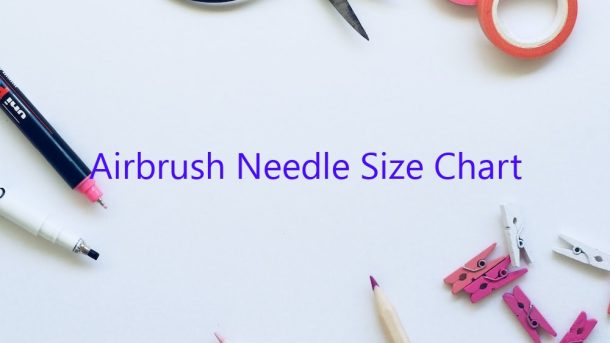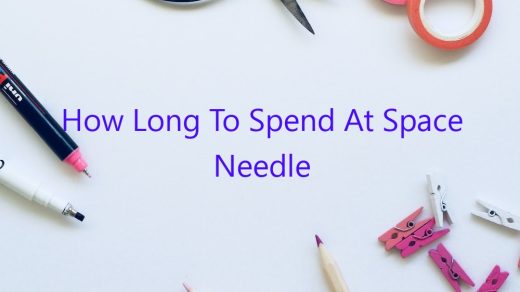An airbrush needle size chart is a helpful guide for finding the right needle size for your airbrush. It provides a range of needle sizes and the corresponding spray patterns for each size.
The most common airbrush needle size is 0.3 mm. This size is good for general purpose spraying. Larger needle sizes produce a wider spray pattern and are better for spraying large areas. Smaller needle sizes produce a more concentrated spray pattern and are better for detail work.
The airbrush needle size chart below shows the range of needle sizes and the corresponding spray patterns.
Contents [hide]
What size needle is best for airbrush?
What is the best size needle for an airbrush?
There is no one definitive answer to this question. Different airbrushes require different size needles. Some airbrushes use very fine needles, while others use needles that are a bit larger.
When choosing a needle size for your airbrush, you need to consider the type of paint you will be using, and the desired spray pattern. If you are using a thicker paint, you will need a larger needle. If you are using a thinner paint, you will need a smaller needle.
If you are using an airbrush for general purpose spraying, a needle size of 0.3 to 0.5 mm is usually ideal. For fine detail work, a needle size of 0.2 mm or less is often recommended.
How does needle size effect airbrush?
When it comes to airbrushing, the size of the needle is an important factor to consider. The size of the needle determines the size of the paint droplets that will be released from the airbrush. A larger needle will release larger paint droplets, while a smaller needle will release smaller paint droplets.
The size of the paint droplets that are released from the airbrush affects the appearance of the finished product. Larger paint droplets will create a thicker, more opaque finish, while smaller paint droplets will create a thinner, more translucent finish.
The size of the needle also affects the amount of paint that is released from the airbrush. Larger needles will release more paint than smaller needles. This is important to consider when choosing an airbrush, as it will determine the amount of time it will take to complete a project.
In general, the size of the needle should be matched to the size of the project. Larger needles are better suited for larger projects, while smaller needles are better suited for smaller projects.
What PSI should I run airbrush?
There is no definitive answer to the question of what PSI to run an airbrush at, as it depends on a variety of factors such as the type of airbrush, the material you are using, and the desired effect. However, a good starting point is to use between 15 and 30 PSI for most applications.
If you are using an airbrush for the first time, it is a good idea to start at the lower end of the PSI range and increase the pressure gradually until you find the right setting for your project. This will help you avoid any accidental overspray or splatter.
It is also important to take into account the type of material that you are using. If you are spraying a thin, water-based paint, you will need a lower PSI than if you are using a thicker, oil-based paint.
Finally, you will also need to consider the effect that you are trying to achieve. If you are trying to create a soft, airbrushed look, you will need to use a lower PSI than if you are trying to achieve a more detailed or high-contrast effect.
Can you airbrush without a needle cap?
Can you airbrush without a needle cap?
Yes, you can airbrush without a needle cap. However, it is not recommended, as it can cause the needle to become clogged.
Does airbrush needle size matter?
When it comes to airbrushing, there are a lot of different factors that go into creating a great finished product. One of the most important factors is the size of the needle. A lot of people might not even think about it, but the size of the needle can make a big difference in the end result.
The size of the needle is important because it determines how much paint is going to be sprayed. A larger needle will spray more paint than a small needle, and that can make a big difference in the final product. If you are trying to create a subtle effect, a small needle is going to be better than a large needle. If you are trying to create a bold effect, a large needle is going to be better.
It’s also important to consider the type of paint you are using. Some paints are thicker than others, and they will require a larger or smaller needle to be used effectively. You need to experiment a little to find the right needle size for the type of paint you are using.
In the end, the size of the needle does matter. It’s important to consider the effect you are trying to achieve, and choose the needle size that is going to give you the best results.
How do I know what needle size I need?
When you’re knitting, you need to use a needle that is the right size for the yarn you’re using. If the needle is too big, the stitches will be loose and the fabric will be too wide. If the needle is too small, the stitches will be tight and the fabric will be too narrow.
The easiest way to determine the needle size you need is to find the recommended needle size for the yarn weight you’re using. The yarn weight is usually printed on the ball band. There are also several online resources that will help you determine the right needle size for the yarn weight you’re using.
Once you know the recommended needle size, you can then use a needle size chart to find the exact size you need. The needle size chart will give you the diameter of the needle in millimeters and inches. You can then use a ruler to measure the diameter of the needle and find the matching size on the chart.
If you’re not sure what the needle size is for the yarn you’re using, you can also knit a swatch and measure the gauge. The gauge is the number of stitches and rows per inch. You can then use the needle size chart to find the recommended needle size for the gauge you achieved.
It’s important to use the right size needle when knitting, or you could end up with a fabric that doesn’t look or fit the way you want it to.
Does a thicker needle hurt more?
In the medical world, there are all sorts of needles. Some are thin, and some are thick. So, the question arises-does a thicker needle hurt more?
There is no definitive answer to this question. Some people say that a thicker needle hurts more, while others say that it doesn’t make a difference. However, there are a few factors that could influence whether a thicker needle hurts more or not.
For one, a thicker needle is going to be bigger in size. This could make it more difficult to insert into the skin, which could cause more pain. Additionally, a thicker needle is going to be more rigid than a thin needle. This could also lead to more pain upon insertion.
However, there are also a few factors that could make a thicker needle less painful. For example, a thicker needle is going to be less likely to bend than a thin needle. This could make it easier to insert into the skin. Additionally, a thicker needle is going to be less likely to go through the skin than a thin needle. This could also make it less painful.
In the end, it is hard to say whether a thicker needle hurts more or not. It really depends on the individual and the situation. However, it is worth considering these factors when making your decision.




